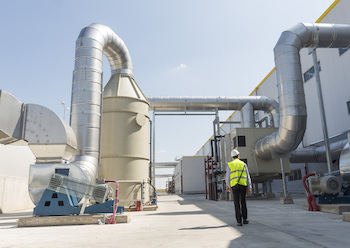
Energy-from-waste facilities tackle the problem of responsible waste disposal while generating electricity for their city or region. This is a win-win situation for consumers, municipalities, and the planet.
The more people there are in the world, the more municipal solid waste (MSW) they will produce. What to do with all that trash? One place it goes is to landfills, as they are an inexpensive solution – but only in the short term. The environmental impact of landfills are many and serious:
• Groundwater contamination
• Methane emissions as waste decomposes
• Poor use of land
• Emissions from gas-powered vehicles traveling long distances
Global efforts to reduce, recycle, and compost help mitigate the waste problem, but trash still remains. Rather than hauling it to landfills, some municipalities are turning garbage into something much more useful: electricity.
The History of Waste-to-Energy in the United States
In the 19th and 20th centuries, the MSW that was not deposited in landfills was incinerated. Uncontrolled burning of trash causes enormous environmental problems in the form of particulates, noxious air emissions, and toxic water discharges.
By banning uncontrolled burning and restricting harmful emissions, the Clean Air Act of 1970 did much to improve air quality. The EPA’s Maximum Achievable Control Technology (MACT) regulations in the 1990s further required incinerators to either install pollution control systems or shut down. Around this time, the facilities that retrofitted mitigation equipment started to recover the energy generated by combusting MSW, rather than wasting it.
As the global population grows, people generate more trash. The good news is that the rate of recycling has also greatly increased, alongside composting and waste to energy (WtE), also called energy from waste (EfW). According to the EPA, 94% of waste was landfilled in 1960; by 2018 that figure had dropped to 50% (EPA.gov, November 2023).

Modern waste-to-energy power plant
Today in the U.S., most EfW facilities are in places with a high population and little space for landfills. The Northeast has the most energy recovery plants, especially along the New York–Washington DC corridor. They are also located in Minneapolis/St. Paul, San Francisco Bay Area, greater Los Angeles, Honolulu, and South Florida. The majority of the plants are operated by two private companies: Covanta Energy and Wheelabrator Technologies.
Internationally, WtE plants are important methods of waste disposal in Scandinavia, Germany, Japan, Taiwan, and Singapore. China has rapidly ramped up its WtE capabilities since 2011, and as of 2023 had 927 such plants (China Dialogue, September 2023).
Because MSW is produced by living organisms (biogenic), it is technically a renewable energy source. Combustion-to-energy-recovery is more sustainable than burning fossil fuels or using landfills, but not as clean an energy source as wind or solar. For this reason, many environmentalists see WtE as only a transitional solution toward decarbonization and a net zero future.
How a Waste-to-Energy Plant Works
Incinerators of the past just burned trash – and polluted the air and water. Today’s WtE plants not only greatly reduce the volume of waste with sophisticated environmental controls in place, they also generate electricity, supply heating/cooling to their municipalities (cogeneration plants), and recover materials for recycling and reuse. WtE generates 0.1% of the electricity in the United States (EIA.gov, October 2023).

Overview of a waste-to-energy facility
Waste-to-energy plants basically work like gas-powered or coal-powered plants, except that the fuel is energy-rich trash: paper, plastic, wood, textile, vegetation, etc. The municipal waste is first dried, as moisture reduces burning efficiency, followed by evaporation. The next zone is degassing, which occurs at higher temperatures. Combustion begins when the treated MSW reaches the flash point of 1,470–2,100°F (800–1,150°C). It then passes through the grate firing for the complete burnout.
The heat that is generated fires an industrial (utility) boiler. The heat turns water into steam, which rotates the blades of a turbine to produce electricity that is sold to utility companies. The steam is then cooled back to water and recirculated back to the boiler.
The waste material that remains is 13% to 3% of the original volume. The greater the temperature, the more complete the incineration. That is why some facilities add an auxiliary fuel, which allows them to achieve temperatures as high as 3,000°F (1,650°C). The incinerator bottom ash (IBA), or slag, is then sorted:
- The recovered metals (iron, copper, aluminum) and rare earth elements are recycled.
- Glass and ceramics are reclaimed and reused.
- The mineral fraction (sand, stone) is used as a basic material in roadwork and construction.
- Anything not reused is buried in landfills.
Incinerating MSW produces pollutants that must be captured and treated. The environmental controls of EfW plants include:
- Carbon injection – a system that blows activated carbon into the hot exhaust gas to absorb mercury and control emissions like dioxins and sulfur dioxide.
- Sprayer dryer – sprays a lime-water slurry onto the hot exhaust to scrub it of acid gases and to make it easier to recover mercury.
- Bag house – a chamber with multiple filters to remove soot, smoke, and metals from the exhaust gas.
- Selective non-catalytic reduction – sprays ammonia or urea onto the exhaust gas to convert polluting nitrogen oxides (NOX) into harmless nitrogen (N2).
Whenever possible, metals are also recovered from the fly ash. What remains is buried in landfills or hazardous waste sites.
This three-part series continues with “Robust Measuring Solutions for Waste-to-Energy Plants.”

